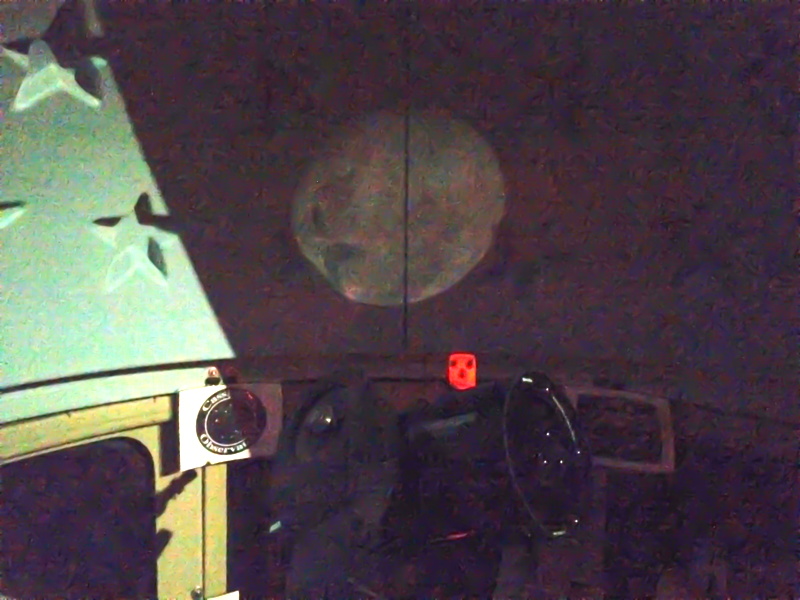Critter, Visitor, Saturn, Moon,
Moon on Dome with iPhone
Posted: 4 June 2015
|
Open: Wednesday, 3 June 2015, 1929 MST Temperature: 87°F |
Session: 832 Conditions: Clear, calm |
On the way to the observatory I saw this packrat:

1930 MST: sunset. Had to sync the observatory clock to WWV as its backup battery had failed during a brief area-wide power outage during the morning.
1939 MST: viewed Venus, 83X. Switched to the Baader 8-24mm Zoom Eyepiece and viewed Jupiter, 250X. Three moons were visible: Io (about to start its transit of the planet), Europa, and Callisto. Ganymede was already in transit and was not visible although its shadow in transit was visible. 1949 MST: Io transit started. Io was visible on limb. Seeing was not good; the best view was at 167X. The Great Red Spot was faintly visible. 2002 MST: Io was now invisible against the bright clouds of Jupiter.
A local telescope owner then arrived for tutoring with her telescope (Celestron refractor). I first showed her some views through the 8" LX200-ACF telescope in the observatory: Jupiter, Venus, and Saturn. Just as we finished viewing Saturn I saw the first Kissing Bug of the night; terminated. She then set up her telescope on the observatory patio and began doing its alignment steps. She has used her telescope only a few times but wants to use it more. I confirmed that what she was doing were the correct steps. When she finished aligning the telescope she did a GOTO Venus, and after some slight assistance from me, she was able to view Venus through her telescope. She also viewed Jupiter and Saturn. I then gave her a challenge: select Messier 13 (Great Globular Cluster in Hercules) and GOTO it. The cluster was impossible to see in the 1X red-dot finderscope due to the bright sky from the waning gibbous Moon but it was just outside of the eyepiece field-of-view (FOV). I centered it and she got to view M13 using her telescope. I then had her GOTO Omega Centauri (globular cluster), which was very low in the southern sky. It also was just outside the FOV so I told her some steps to take to locate objects when the GOTOs were slightly off. With Omega Centauri centered, it was faintly visible as a large "fuzz ball". After a successful period of using her telescope, during which she did great given her limited experience with the telescope, she left at 2142 MST.
The waning gibbous Moon had now risen over the hill to the southeast. Viewed Saturn, 250X (zoom eyepiece). Seeing was still not very good. Began setting up for imaging using the D7200 DSLR. Saw and terminated a 2nd Kissing Bug. Did some eyepiece projection (222X) HD video recordings, 1.3X crop factor, 60 fps, at various shutter speed and ISO settings. This is a stack of 930 frames using Keith's Imager Stacker, 1/60sec, ISO 6400:

Wish the seeing had been better.
2214 MST: completed Saturn imaging and removed the camera. Slewed to the Moon, not quite above a tree, and viewed it at 83X. Began waiting for it to clear the tree, which it did at 2229 MST. Took this handheld iPhone 5s afocal 83X photo (cropped) of the Moon:

I then stepped outside of the observatory and used NightCap Pro on my iPhone 5s to take this handheld photo of the Moon being projected onto the observatory dome:

2244 MST: last look at the Moon, 83X.
|
Close: Wednesday, 3 June 2015, 2251 MST Temperature: 71°F |
|
Comments are welcome using Email. If you are on Twitter you can use the button below to tweet this report to your followers. Thanks.
Cassiopeia Observatory Home Page
Copyright ©2015 Michael L. Weasner / mweasner@me.com
URL = http://www.weasner.com/co/Reports/2015/06/04/index.html
